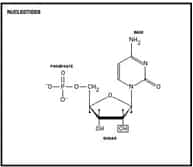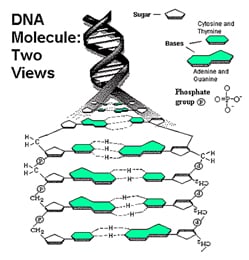Nucleic acids are the storage form of all the genetic information required by a cell.
They also are the cell’s preferred energy molecule ATP as well as acting as being used as intermediate electron carrier molecules in cellular respiration in the form of NAD+ (nicotinamide adenine dinucleotide) and FAD (flavin adenine dinucleotide). cAMP (cyclic adenosine monophosphate) is also a secondary messenger molecule in various hormone interactions.
DNA and RNA are both polymers made up of subunits called nucleotides.
DNA – Deoxyribonucleic Acid
- Double stranded, with each strand running in opposite directions. This is referred to as anti-parallel.
- One strand runs 5’ > 3’, the other runs 3’ > 5’
- The two strands are held together by hydrogen bonding between complimentary base pairs.
- Adenine binds with Thymine and they are held together by 2 hydrogen bonds.
- Guanine binds with Cytosine and they are held together by 3 hydrogen bonds.
RNA – Ribonucleic Acid
- Single stranded
- Uracil replaces thymine
- synthesized in the nucleus by the process of transcription but travels to the ribosomes in the cytoplasm to be translated into a polypeptide with a specific amino acid sequence
- exists in three forms
- mRNA – messenger RNA
- rRNA – ribosomal RNA
- tRNA – transfer RNA



